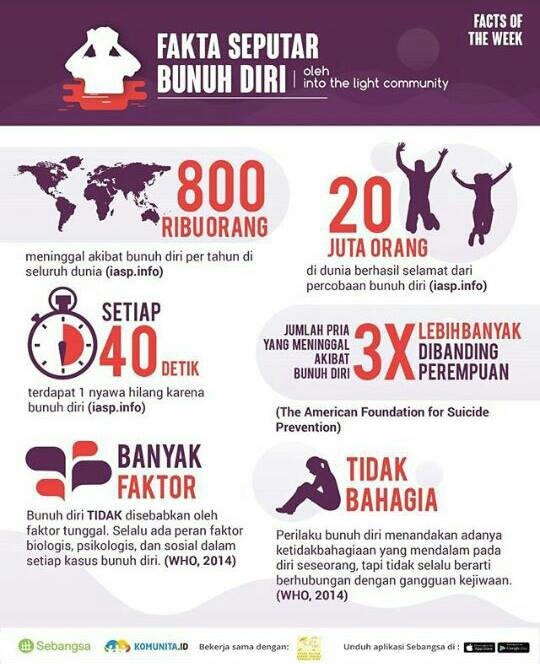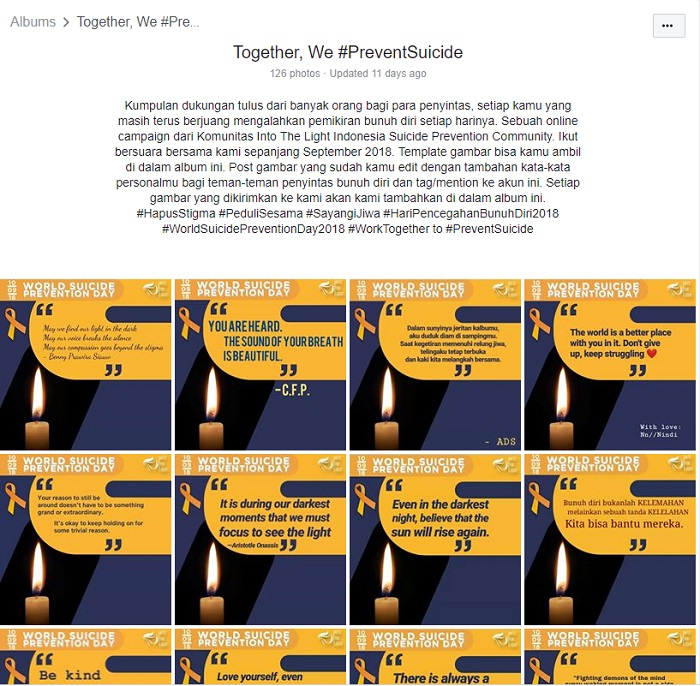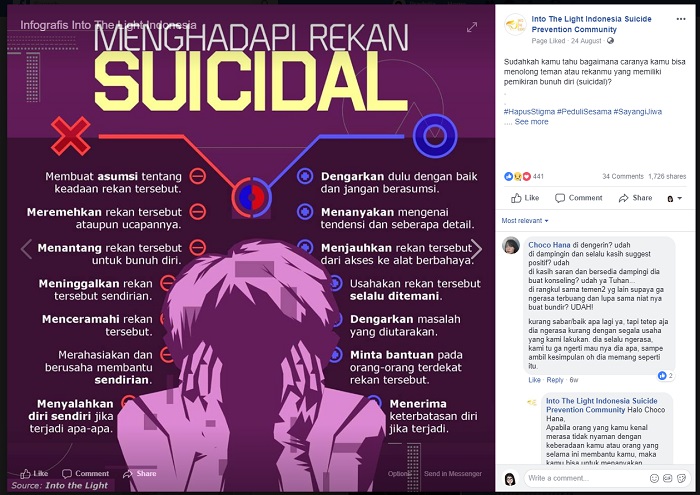Rizanna Rosemary, Pradytia Pertiwi & Inri Denna
The tragic suicide of Jong Hyun, a member of the popular Korean boy band SHINee, shocked fans around the world, including in Indonesia. The news went viral and, upon hearing of his death, two young Indonesian fans attempted suicide. An Asia-based news source called this phenomenon the ‘Werther effect’, commonly known as ‘copycat suicide’.
In an age dominated by instant messaging and the internet, media influences play a role in increasing the risk of suicide and self-harm among vulnerable young people. However, the internet and social media can also be used to cut through stigma and misinformation regarding suicide, and to raise awareness of the issue among youth in Indonesia.
Youth suicide
Suicide is a global health issue and is ranked as the second most common cause of death among people aged 15 to 29 years worldwide. The World Health Organisation (WHO) reported that 78 per cent of all suicides in 2016 occurred in low- and middle- income countries (LMICs). While there is a strong correlation between suicide and mental health problems in high-income countries, suicide in LMICs tends to be compounded by social stigma and the difficulties associated with speaking openly about it with friends and family. Research suggests that young people are particularly vulnerable to media influences on suicide coverage compared to adults. Early exposure to media content on suicide is reported to increase the likelihood of the long-term development of suicide ideation among adolescents and, further, suicide attempts in their adulthood.
WHO estimates that the suicide rate among Indonesians is 3.4 per 100,000 people. The true rate is likely higher, however, as suicide is often not identified as the cause of death during the death registration process. Where the cause of death is unknown, it is likely that a qualified doctor was not available to make an assessment. National data on suicide among young people does not exist in Indonesia, but research on suicide among youth in Indonesia paints an alarming picture. According to a survey of more than 400 young people in Semarang, Central Java, one in three young people have had suicidal ideation or thoughts in the past. These people were aware of methods for carrying out suicide, which they had often learned from coverage of suicide cases in the media. Suicidal ideation and suicide attempts were also reported among youth in other parts of Indonesia. Suicide attempts were driven by factors such as depression and other mental health issues, family issues, personal failures and loneliness. The most worrying finding is that young people tend to keep suicidal thoughts to themselves, rather than sharing them with others, which means that the risk is left undetected.

Evidence suggests that the prevailing social stigma surrounding suicide prevents young people with suicidal thoughts from speaking openly and seeking support. Suicide is still a taboo subject in Indonesia. People’s misinterpretation of a religious ruling contributes to this lingering stigma. For example, there is an ayat (verse) in the Holy Qur’an that forbids suicide: ‘And do not kill yourselves [or one another]’ (QS 4: 29). This ayat presents Islam as strongly prohibiting suicide. Furthermore, Muhammad al-Bukhari and Muslim ibn al-Hajjaj, two prominent historic Muslim scholars, record in the hadiths that the Prophet Mohammad states that suicide is a sinful act: ‘Whoever kills himself with a piece of iron will have that iron in his hand, thrusting it into his belly in the fire of hell for ever and ever … or will be punished with it on the Day of Resurrection’. Many, including the families of those who attempt or complete a suicide, allude to the hadith’s message as ‘self-murder means hell’ and use the phrase to judge and mock the victims for not having had enough faith in God rather than trying to prevent them from attempting suicide.
Suicide victims and survivors are perceived as ‘evildoers’ and their behaviour condemned as deviant. Similarly, research involving families of suicide victims shows that blame is placed on family members and friends for failing to prevent the ‘self-murder’. This ‘victim-blaming’ practice is thought to discourage people with suicidal inclinations and mental health issues from seeking help, and to prevent grieving family and friends from telling the truth about what happened to a loved one and openly discussing the issue. A 19-year-old survivor says, ‘I have always been anxious and depressed since 2012 but I felt afraid to have myself checked by professionals or talk about my mental health problems to my family because I was worried that they would blame me. I had attempted suicide in 2017 and since then I have never stopped thinking about how to end my life.’
Poor government-led initiatives
Mental Health Law No.18/2014 regulates the promotion, prevention, treatment and rehabilitation of mental illnesses, but does not discuss suicide. This creates a structural barrier that limits systematic efforts to address suicide risks. Suicide is not receiving the same level of funding and attention as other issues that put youth at risk, such as drug abuse. To date, government efforts on youth suicide and mental health-related problems narrowly focus on providing treatment for those who are suicidal, while ignoring the broader issue underpinning suicide attempts among young people in the country: suicide-related stigmas. Moreover, the government’s approaches are out-of-date in their focus on non-interactive media, which do not appeal to young people.
For example, in 2010, the Indonesian Ministry of Health established a dedicated hotline, which offered free counselling to those with depression or at risk of suicide. However, the public response was miniscule: 161 people utilised the service in its first year and it took two years before this number doubled to a mere 347 people in 2012. The service did not last long. By 2014 the number of users declined to just 46 people and the Ministry closed the service. The Ministry reported that the responses were dominated by calls seeking general information on mental health issues instead of seeking counselling on suicidal ideation. Rather than seeing this as a positive outcome in raising awareness, the Ministry considered the service ineffective. Upon closing it, the Ministry asked those in need of counselling to consult with the nearest primary healthcare centre (puskesmas) or hospital. The government’s approach thus continues to narrowly focus on treatment while neglecting early prevention strategies, such as addressing the broader stigma surrounding suicide.
A smartphone app called ‘Sehat Jiwa’ (mentally healthy) launched by the Ministry in 2015 had a better response with 1000 users downloading the app by October 2018. Sehat Jiwa is intended to reduce the number of mental health-related suicides. It provides information and education regarding the most common mental health problems such as stress, anxiety, sleep-deprivation and depression. It also contains a feature for early detection screening for symptoms of mental health problems and a referral system for further treatment. The app could also be used by members of the community or family to report on those suspected of being at risk of attempting suicide, which would be followed up by either a health professional/institution or Public Order Enforcers (Satpol PP). However, this seemingly comprehensive technology-based intervention is non-interactive as it does not provide space for users to post questions and further discuss suicide and mental health problems, such as the results of early screenings that are crucial to preventing suicide. As the 19-year old survivor shared above, difficulty in communicating their mental health problems is a major hurdle that hampers them from finding the help necessary to mitigate early development of suicide ideation.
In a country of over 260 million people, the number of responses towards the two services is staggeringly low. The government-led programs ignore social media – the most popular and interactive online platforms accessed by young people to seek information, socialise and build relationships. Globally, there is a growing trend in using social media as a tool in promoting health-related intervention programs targeting young people including sexual health and suicide prevention. Its interactive features allow young people to connect and engage with those who share common interests and concerns and provide space for sharing their experiences (often in an anonymous setting), which leads to positive outcomes in raising awareness concerning the issues. A 2017 survey by the Indonesia Internet Service Provider Association found that 132.7 million Indonesians used the internet of whom 49.52 per cent were aged 19 to 34 years. Accessing social media content is the second most common online activity that young people engage in after chatting, which indicates its potential value for addressing suicide among youth in Indonesia.
De-stigmatise ‘going to hell’
The strength of social media has been recognised by a number of community-based initiatives that promote suicide prevention and address mental health problems. At least eight community groups that provide education, advocacy and support on the issue have emerged in recent years. ‘Into the Light’ is the first inclusive, youth-driven community group that focuses specifically on suicide prevention. It was the negative effects of social stigma surrounding suicide and the little attention paid by health activists and the government to tackling this issue that inspired Benny Prawira Siauw to establish the community in 2013. Into the Light began as a Facebook page, and has since expanded to Twitter and Instagram. Currently, it has over 8000 followers on Facebook, nearly 6000 on Instagram and more than 4000 on Twitter, the majority of whom are young people. Into the Light largely focuses on raising awareness by regularly posting articles, stories, or infographics, which contain facts and information pertaining to mental health and suicide prevention. Some of the common hashtags they use are #StayAlive and #PreventSuicide.
For example, on Suicide Prevention Day in 2018, Into the Light provided an editable ‘World Suicide Prevention Day’ banner to which their followers could add a positive message and share online by using the hashtag #CegahBunuhDiri (#PreventSuicide). The post was liked by 359 people on Instagram and 126 followers responded on Twitter with custom-made banners presenting their individual personal messages to support peers with suicidal thoughts. As a follower shared, ‘You don’t have to fight this battle alone, we are here for you’. Another example is an infographic titled ‘I deal with suicidal people’, which was shared by 1726 people on Facebook and triggered further discussion online. A user might comment, ‘I’d like to know how to deal with our own suicidal thought[s],’ to which an Into the Light admin or other followers could respond. Some fellow followers posted encouraging comments, such as, ‘We cannot avoid problems, but suicide is also not a solution’. Social media posts enable young followers to gain an understanding of the issues surrounding suicide, develop trust, and receive social support, which can then lead to further discussions of the previously unspoken topic of suicide. These kinds of spaces were not offered in the government’s past initiatives.

Benny's organisation also seeks to influence the mainstream media, which often propagates negative stigma such as victim blaming through their insensitive and sensationalist coverage of suicide. Benny says that mainstream media coverage of suicide often shows disturbing photographs of the deceased and provides details of the suicide method used, which could influence young people to develop suicidal ideation or make copycat suicide attempts. Benny is currently supporting the media by producing guidelines that offer recommendations for reporting on suicide, including respecting victims’ identity and privacy. He hopes that his guidelines will encourage the media to present more trustworthy and healthy information on the subject.
Endorse #StayAlive
Social media is a double-edged sword, playing a part in triggering suicidal ideation among young people but at the same time having the power to reduce stigma. As more youngsters reach out to Into the Light and other initiatives like it, through interactive social media platforms, the government may begin to notice the progress made by grassroots initiatives and invest in social media-based approaches. Collaboration with existing online communities is one way the government can campaign to raise awareness and implement programs that endorse a positive message about staying alive. The approach would not only boost responses to suicide prevention programs, but might also save lives.
Rizanna Rosemary (rizanna.rosemary@sydney.edu.au) is a PhD candidate at the Media and Communication Department, Faculty of Arts and Social Sciences, The University of Sydney.
Pradytia Pertiwi (pradytia.putri@gmail.com) is a PhD candidate at the Centre for Disability Research and Policy, Faculty of Health Sciences, The University of Sydney.
Inri Denna (inridenna@gmail.com) has a masters of Health Communication, is an alumni of The University of Sydney, and currently works at the Indonesian Ministry of Health.
